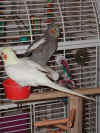 Mollie
was our first bird. She is a Lutino Cockatiel, mostly yellow but for two
red spots over her ears. She is very beautiful, and the smallest of our
six parrots. These birds are originally from Australia (all our parrots
were born and raised in the USA.) The Lutino does not exist in the wild,
the normal cockatiel is gray with white, yellow and the red cheek marks. Daisy
is a Normal Gray Cockatiel, and she is next to Mollie outside their cage.
Female cockatiels do not talk much, nor do they whistle tunes like the males
do. We loved these two so much we went on to get more, in the order shown below.
Mollie
was our first bird. She is a Lutino Cockatiel, mostly yellow but for two
red spots over her ears. She is very beautiful, and the smallest of our
six parrots. These birds are originally from Australia (all our parrots
were born and raised in the USA.) The Lutino does not exist in the wild,
the normal cockatiel is gray with white, yellow and the red cheek marks. Daisy
is a Normal Gray Cockatiel, and she is next to Mollie outside their cage.
Female cockatiels do not talk much, nor do they whistle tunes like the males
do. We loved these two so much we went on to get more, in the order shown below.
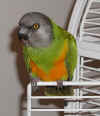 Julie
was our third bird, she is found in Africa as her name suggests: she is a
Senegal Parrot. Actually we are not sure of her "sex." We
really suspect her behavior is that of a male, but since we started to call her
Julie, Julie it will be... It is hard to tell the sexes apart in Senegal
Parrots. But this one has a large head, and will fight any other animal
regardless of size. Julie thinks she is the boss and owns every toy
around. She scares all the other parrots, and she is not scared of people,
cats, etc. This means Julie is most likely a male bird.
Julie
was our third bird, she is found in Africa as her name suggests: she is a
Senegal Parrot. Actually we are not sure of her "sex." We
really suspect her behavior is that of a male, but since we started to call her
Julie, Julie it will be... It is hard to tell the sexes apart in Senegal
Parrots. But this one has a large head, and will fight any other animal
regardless of size. Julie thinks she is the boss and owns every toy
around. She scares all the other parrots, and she is not scared of people,
cats, etc. This means Julie is most likely a male bird.
 Originally,
we named him Dakota. He started to call himself Dakoko, hence we decided
to call him Koko. Koko is a Blue-Front Amazon. He is the most
colorful of our birds. In reality we are not sure if Koko is a male or a
female. We have not tested him to find his sex. Dakota in Native
American means "friend" and he is true to his name a great
friend. The feather at the bottom of all these pages is from Koko's
tail. It has blue, green, turquoise, red, and yellow. He also has
(on his wings) navy blue and black. A very friendly and beautiful parrot. He talks
well, announces dinner, and asks for a treat when he wants one! As his
name indicates he is from the Amazon region in South America. P.S. We have
since found (from a genetic test on a blood sample) that Koko is a male.
Originally,
we named him Dakota. He started to call himself Dakoko, hence we decided
to call him Koko. Koko is a Blue-Front Amazon. He is the most
colorful of our birds. In reality we are not sure if Koko is a male or a
female. We have not tested him to find his sex. Dakota in Native
American means "friend" and he is true to his name a great
friend. The feather at the bottom of all these pages is from Koko's
tail. It has blue, green, turquoise, red, and yellow. He also has
(on his wings) navy blue and black. A very friendly and beautiful parrot. He talks
well, announces dinner, and asks for a treat when he wants one! As his
name indicates he is from the Amazon region in South America. P.S. We have
since found (from a genetic test on a blood sample) that Koko is a male.
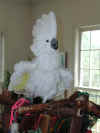 Tata
is a majestic Umbrella Cockatoo. His origin is Indonesia. He is the
most intelligent of our birds, and he can take apart and assemble children's
toys (age 3 to 4 years.) He knows hundreds of words, and will use them as
he sees fit. He can be very loud when he is unhappy or if he wants
something. When we first got him, we spent many weeks trying to name him,
but none of our ideas for a name sounded good. One day he said to me
"Hi Tata!" That was it! Tata named himself. Most
importantly, he knows how to say his name well, and he knows when we address
him. He is definitely a male bird and he loves to display his
feathers. When we got him as a baby, I fed him with a spoon for nearly a
year, hence he thinks I am his most significant parent.
Tata
is a majestic Umbrella Cockatoo. His origin is Indonesia. He is the
most intelligent of our birds, and he can take apart and assemble children's
toys (age 3 to 4 years.) He knows hundreds of words, and will use them as
he sees fit. He can be very loud when he is unhappy or if he wants
something. When we first got him, we spent many weeks trying to name him,
but none of our ideas for a name sounded good. One day he said to me
"Hi Tata!" That was it! Tata named himself. Most
importantly, he knows how to say his name well, and he knows when we address
him. He is definitely a male bird and he loves to display his
feathers. When we got him as a baby, I fed him with a spoon for nearly a
year, hence he thinks I am his most significant parent.
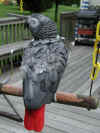 We
got Ernie from his previous owner because he started biting her. He has
never bitten me yet, and I love him very much. He is an African Gray, from
the Congo, central Africa. Ernie was born in Virginia, this we can tell by
the band around his foot. Ernie is a feather picker, just like he was when we got
him. After one year, he stopped feather picking, and he had a perfect
cover of feathers. However, when the days started to get longer, he
started to pick his feathers again. We think it is a hormone related
matter since our Avian Vet told us Ernie is in very good health. He is now
10 years old (2003.) Ernie can imitate any sound he hears. This
includes but not limited to: sirens, microwave oven, phone ringing, truck
backing up, and many other intriguing sounds.
We
got Ernie from his previous owner because he started biting her. He has
never bitten me yet, and I love him very much. He is an African Gray, from
the Congo, central Africa. Ernie was born in Virginia, this we can tell by
the band around his foot. Ernie is a feather picker, just like he was when we got
him. After one year, he stopped feather picking, and he had a perfect
cover of feathers. However, when the days started to get longer, he
started to pick his feathers again. We think it is a hormone related
matter since our Avian Vet told us Ernie is in very good health. He is now
10 years old (2003.) Ernie can imitate any sound he hears. This
includes but not limited to: sirens, microwave oven, phone ringing, truck
backing up, and many other intriguing sounds.
 In
October 2004 while giving Ernie a shower I noticed he would raise his left wing
to catch water, but not his right wing. Upon looking closer, I could see a
large blood scab under his right wing. He had a bad infection. We took him
to see Dr. Scott Stahl in Vienna, VA. Dr. Stahl and his staff actually
saved Ernie's life. For more details go to Ernie's
Collar.
In
October 2004 while giving Ernie a shower I noticed he would raise his left wing
to catch water, but not his right wing. Upon looking closer, I could see a
large blood scab under his right wing. He had a bad infection. We took him
to see Dr. Scott Stahl in Vienna, VA. Dr. Stahl and his staff actually
saved Ernie's life. For more details go to Ernie's
Collar.
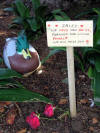 Update.
On Wednesday, May 2, 2007 Daisy was egg-bound. This is something that
happens frequently with Cockatiels. I was riding my bicycle and when I
came home Felicia had taken her to the vet. The vet attempted to remove
the bound egg, but could only remove some of it. Three hours later, early
in the evening we were told Daisy passed away. We loved Daisy so much we
were very sad and in pain for her loss. I could not bury her for many
days. Finally I got the courage to dig a grave and bury Daisy.
Felicia wrote a note on her grave, and we put her under the pine tree where the
ducks stay most of the day keeping her company. Also a decoy is looking
over her. We really miss Daisy, and think of her very often.
Update.
On Wednesday, May 2, 2007 Daisy was egg-bound. This is something that
happens frequently with Cockatiels. I was riding my bicycle and when I
came home Felicia had taken her to the vet. The vet attempted to remove
the bound egg, but could only remove some of it. Three hours later, early
in the evening we were told Daisy passed away. We loved Daisy so much we
were very sad and in pain for her loss. I could not bury her for many
days. Finally I got the courage to dig a grave and bury Daisy.
Felicia wrote a note on her grave, and we put her under the pine tree where the
ducks stay most of the day keeping her company. Also a decoy is looking
over her. We really miss Daisy, and think of her very often.
